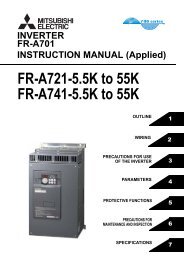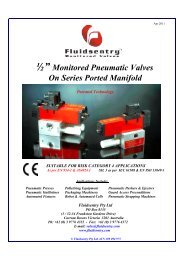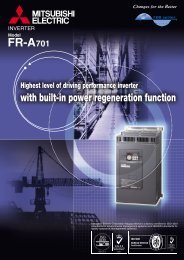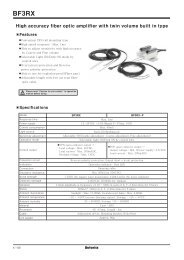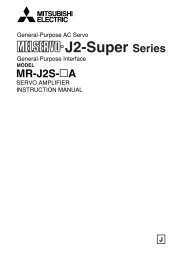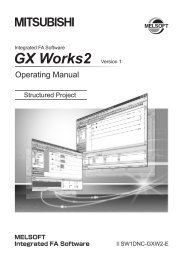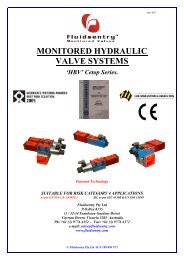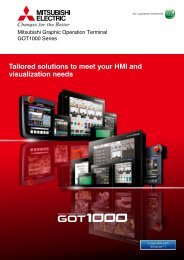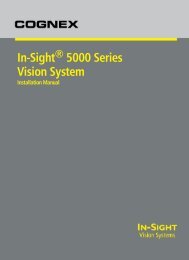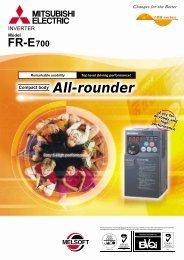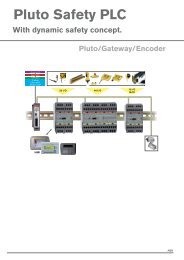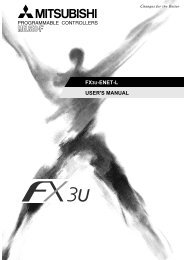- Page 1 and 2: The Safety HandbookExperience - Sys
- Page 3 and 4: IntroductionWe develop innovative p
- Page 5 and 6: Our products revolutionise the mark
- Page 7 and 8: Jokab Safetys developments of the 8
- Page 9 and 10: The Machinery Directive; for machin
- Page 11 and 12: Protection or warning?How is it pos
- Page 13: New standards for safety incontrol
- Page 17 and 18: CategoryThe structure for the compo
- Page 19 and 20: Theoretical approach for multiple m
- Page 21 and 22: A mechanical switch doesnot give a
- Page 23 and 24: Training in risk analysisWe regular
- Page 25 and 26: ContentsPage1Why you should use the
- Page 27 and 28: - to supervise safety devices!Light
- Page 29 and 30: 1Pluto B46Pluto AS-i246 I/OSafe bus
- Page 31 and 32: Technical info - PlutoDynamic signa
- Page 33 and 34: Technical data - generalManufacture
- Page 35 and 36: Input connectionThe system offers s
- Page 37 and 38: Technical data - generalManufacture
- Page 39 and 40: Certificates12345678910111213ABB2:1
- Page 41 and 42: Electrical connections1234567891011
- Page 43 and 44: Pluto 1 settings - Machine cabinet1
- Page 45 and 46: 2:21ABB1234567891011131412
- Page 47 and 48: 2:23ABB1234567891011131412
- Page 49 and 50: Technical data - GATE-P2Manufacture
- Page 51 and 52: Technical data - GATE-D2Manufacture
- Page 53 and 54: Technical data - GATE-C2Manufacture
- Page 55 and 56: Technical data - GATE-E2Manufacture
- Page 57 and 58: Technical data - Safe Encoder RSA 5
- Page 59 and 60: Safe EncoderFunction block for a si
- Page 61 and 62: ContentsPage1Why should I use the b
- Page 63 and 64: How does the bus system AS-Interfac
- Page 65 and 66:
1Easy connections to the AS-i cable
- Page 67 and 68:
Technical information - Pluto AS-iI
- Page 69 and 70:
Technical data - generalManufacture
- Page 71 and 72:
Why should you usesafety node Urax?
- Page 73 and 74:
Technical data - Urax-A1/A1RManufac
- Page 75 and 76:
Technical data - Urax-B1RManufactur
- Page 77 and 78:
Technical data - Urax-C1 and C1RMan
- Page 79 and 80:
Technical data - Urax-D1RManufactur
- Page 81 and 82:
Technical data - Urax-E1Manufacture
- Page 83 and 84:
12345678910111213ABB3:2314
- Page 85 and 86:
ContentsPage1Pluto Manager ________
- Page 87 and 88:
List of standards and special funct
- Page 89 and 90:
ContentsPage1Safety system - Dynami
- Page 91 and 92:
Vital is available in three variant
- Page 93 and 94:
Number of Tinas that can be used wi
- Page 95 and 96:
How does a dynamic circuit of Vital
- Page 97 and 98:
Vital 1 Safety controller1Dynamicci
- Page 99 and 100:
Technical data - Vital 1Manufacture
- Page 101 and 102:
Three connection alternativesAccord
- Page 103 and 104:
Operating mode M1 - Separate functi
- Page 105 and 106:
Technical data - Vital 2Manufacture
- Page 107 and 108:
Operating mode M1 - Separate functi
- Page 109 and 110:
Technical data - Vital 3Manufacture
- Page 111 and 112:
Tinais available in several version
- Page 113 and 114:
Adaptation unitTina 2A/BTina 2A/B i
- Page 115 and 116:
Connection blockTina 4ATina 4A is a
- Page 117 and 118:
Bypassing of Eden and Tina units.If
- Page 119 and 120:
Adaptation unitTina 7ATina 7A is a
- Page 121 and 122:
Connection examples of safety senso
- Page 123 and 124:
Technical data - Tina 10A/B/CManufa
- Page 125 and 126:
Terminal blockTina 12ATina 12A is a
- Page 127 and 128:
1Example of safety sensors connecti
- Page 129 and 130:
HA3300A-01 Connection example Vital
- Page 131 and 132:
HA3303A Vital 1 with emergency stop
- Page 133 and 134:
HA3306D Vital 1 with 3 lightbeams S
- Page 135 and 136:
HE3811B-01 Safety light beam Spot w
- Page 137 and 138:
HE3824F-01 Eden and 2 bypass lightb
- Page 139 and 140:
HH3302D Vital 1 with Tina 8A and di
- Page 141 and 142:
HB0006A Vital with 4 Eden units + R
- Page 143 and 144:
HB0003A Pluto with Smile and Inca e
- Page 145 and 146:
12345678910111213ABB5:5714
- Page 147 and 148:
ContentsPage1Why should you use Saf
- Page 149 and 150:
The most flexible safety relayson t
- Page 151 and 152:
1Technical dataSafety categorySafet
- Page 153 and 154:
Technical information - RT6InputsTh
- Page 155 and 156:
Technical data - RT6ManufacturerArt
- Page 157 and 158:
Technical information - RT7 A/BInpu
- Page 159 and 160:
ABBTechnical data - RT7 A/BManufact
- Page 161 and 162:
Technical information - RT9InputsTh
- Page 163 and 164:
Technical data - RT9ManufacturerABB
- Page 165 and 166:
ABBTechnical data - JSBRT11Manufact
- Page 167 and 168:
Technical data - JSBR4ManufacturerA
- Page 169 and 170:
Technical data - JSBT4ManufacturerT
- Page 171 and 172:
Technical data - BT50(T)Manufacture
- Page 173 and 174:
Technical data - BT51(T)Conductor w
- Page 175 and 176:
Technical data - JSBT5(T)Manufactur
- Page 177 and 178:
Technical data - JSHT1 A/BManufactu
- Page 179 and 180:
Technical data - JSHT2 A/B/CManufac
- Page 181 and 182:
Technical data - E1TManufacturerArt
- Page 183 and 184:
Technical data - JSR1TManufacturerA
- Page 185 and 186:
Technical data - JSR2AManufacturerA
- Page 187 and 188:
Technical data - JSR3TManufacturerT
- Page 189 and 190:
HA5400A Connection examples JSBR412
- Page 191 and 192:
HA6501B Connection examples BT50T12
- Page 193 and 194:
HA7600A Connection examples RT61234
- Page 195 and 196:
HA7900A Connection examples RT91234
- Page 197 and 198:
HG7636B Focus light grid/curtain wi
- Page 199 and 200:
HG7654A Interlocked door with RT6 a
- Page 201 and 202:
HG7674B Safety interlock switch JSN
- Page 203 and 204:
HL7600B Several JSNY7 connected to
- Page 205 and 206:
HP7600B Machine control-Isolation o
- Page 207 and 208:
HB0008A Focus light curtain/light b
- Page 209 and 210:
ContentsPage1Why use light beams/li
- Page 211 and 212:
Light grids for long distancesLight
- Page 213 and 214:
Muting(bypassing)Automatic bypassin
- Page 215 and 216:
Cycle initiation withlight curtain1
- Page 217 and 218:
Safety distance for light beams acc
- Page 219 and 220:
are activated. If for example durin
- Page 221 and 222:
12FII-4-K2-500 FII-4-K4-zzzz D FII-
- Page 223 and 224:
Muting (bypassing)- Focus II12Built
- Page 225 and 226:
Muting with FMC and FMI units1234Th
- Page 227 and 228:
Muting sensors - Mute RRetro-reflec
- Page 229 and 230:
Muting with Mute R and Mute D1A sol
- Page 231 and 232:
Technical data - BjornManufacturer:
- Page 233 and 234:
Blanking programmerBP1- a quick way
- Page 235 and 236:
HR7000C-01 Focus - Connection witho
- Page 237 and 238:
HR7000H-01 Focus - Connection with
- Page 239 and 240:
HR7000L-01 Tina 10A, 10B and 10C co
- Page 241 and 242:
HR7000Q Cable connection example123
- Page 243 and 244:
Mounting and alignment - SpotSafety
- Page 245 and 246:
Connection of Spot T/R to Vital1123
- Page 247 and 248:
Software - Look scannerFunction but
- Page 249 and 250:
12345678910111213ABB7:4114
- Page 251 and 252:
ContentsPage1Stopping time ________
- Page 253 and 254:
Stopping time and MachineDiagnosis
- Page 255 and 256:
Saving• Select measurement series
- Page 257 and 258:
SM5 1250/2500 Linear sensorThe SM5
- Page 259 and 260:
ContentsPage1Why should you use sen
- Page 261 and 262:
Eden -highest safety level and reli
- Page 263 and 264:
Application examples - EdenEden to
- Page 265 and 266:
Technical data - EdenManufacturerAr
- Page 267 and 268:
Technical data - JSNY5ManufacturerA
- Page 269 and 270:
13Technical data - JSNY7Manufacture
- Page 271 and 272:
Technical data - JSNY8ManufacturerA
- Page 273 and 274:
Technical data - JSNY9Utilisation c
- Page 275 and 276:
Models and accessoris - MagneHandle
- Page 277 and 278:
Dimensions - Magne123Dimensions Mag
- Page 279 and 280:
Connection example - Magne 1 in ser
- Page 281 and 282:
Modular structure - Dalton1. Choose
- Page 283 and 284:
Dimensions - Dalton1234Bracket 1 wi
- Page 285 and 286:
Connection example - Dalton M12 and
- Page 287 and 288:
Knox in 4 different states1OpenRese
- Page 289 and 290:
Technical data - KnoxMakeSafety lev
- Page 291 and 292:
Connection example - Knox with down
- Page 293 and 294:
ContentsPage1Why should control dev
- Page 295 and 296:
12Two-channel all the way out to th
- Page 297 and 298:
Highest safety levelwhether the but
- Page 299 and 300:
Available combinations of bottom- a
- Page 301 and 302:
Connection example - Three-position
- Page 303 and 304:
Connection with bottom parts AE1234
- Page 305 and 306:
Technical data - SafeballManufactur
- Page 307 and 308:
Electrical connection - SafeballTwo
- Page 309 and 310:
For mobile installation12JSTD25F/JS
- Page 311 and 312:
Connection example - JSTD25P-11234D
- Page 313 and 314:
Technical data - JSTD20Manufacturer
- Page 315 and 316:
ContentsPage1Why do you need an Eme
- Page 317 and 318:
Emergency stop for enclosureinstall
- Page 319 and 320:
Technical data - INCA 1/INCA 1 Tina
- Page 321 and 322:
Connection examples - SmileSmile 10
- Page 323 and 324:
Technical data - SmileManufacturer:
- Page 325 and 326:
Connection examples - Smile TinaSmi
- Page 327 and 328:
Technical data - Smile TinaManufact
- Page 329 and 330:
Technical data - Smile AS-iManufact
- Page 331 and 332:
Technical data - Stop-LineManufactu
- Page 333 and 334:
Ordering data - Stop-Line accessori
- Page 335 and 336:
Reset buttonSmile 11RWhen do I need
- Page 337 and 338:
ContentsPage1When shall I use conta
- Page 339 and 340:
Safety contact rails GP - General1T
- Page 341 and 342:
Mounting and electrical connection
- Page 343 and 344:
Standard shapes1Shape AShape BCusto
- Page 345 and 346:
Technical Data - Safety MatsManufac
- Page 347 and 348:
Electrical connection - Safety cont
- Page 349 and 350:
12345678910111213ABB 12:1314
- Page 351 and 352:
ContentsPage1Guick-Guard ® fencing
- Page 353 and 354:
A flexible and stable fencing syste
- Page 355 and 356:
Quick-Guard ® is supplied in three
- Page 357 and 358:
Quick-Guard ® E- can be ordered in
- Page 359 and 360:
IMAGE DESIGNATION ART.NO. DESCRIPTI
- Page 361 and 362:
Quick-Guard ® Assembly, standard v
- Page 363 and 364:
Dimensions for aluminum profile len
- Page 365 and 366:
Designation: JSM A8888Article numbe
- Page 367 and 368:
Cable tieDesignation: JSM X1Article
- Page 369 and 370:
Small Angle fitting, e.g. Electrica
- Page 371 and 372:
DOOR COMPONENTSTo mount conventiona
- Page 373 and 374:
Designation: JSM D18 HandleArticle
- Page 375 and 376:
Upper Door bolt1Upper Door boltDesi
- Page 377 and 378:
Sliding bolt for Eden1Designation:
- Page 379 and 380:
Guide Components for Sliding Door1G
- Page 381 and 382:
FITTINGS FOR SWITCHES1Eden fittings
- Page 383 and 384:
Fittings for Interlock Switches JSN
- Page 385 and 386:
ACCESSORIESAll fittings and door co
- Page 387 and 388:
18-12SteelplateCross-bent sheet met
- Page 389 and 390:
FunctionHighest protection in accor
- Page 391 and 392:
ContentsPage1Declaration of conform
- Page 393 and 394:
Declaration of conformity - JSBR4Ot
- Page 395 and 396:
Declaration of conformity - Eden, T
- Page 397 and 398:
Declaration of conformity- KnoxOthe
- Page 399 and 400:
NotesABB 14:9
- Page 401:
NotesABB 14:11



